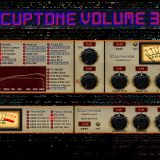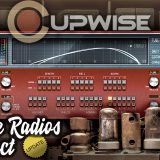Archive
Jpn wanted to do an N4 skin for Flucti, so I decided to do a quick, simple update to the programs that makes a few improvements.
Flucti updates list-
*New N4 skin by JPN!
*N3 skin has been updated. Cosmetically improved, and also the knobs in the old skin were a little buggy. You had to click on the top half of them to get them working. Fixed. Also, the following updates have been reflected in the skin.
*Dry control in the past was a control that just added some dry signal back in, but didn’t lower the wet signal, so it was awkward to use. And actually, for this release, the dry control didn’t even work at all! I didn’t have it set up properly so it did nothing. Now the control is called ‘wet’ and acts as a wet/dry mixer control, which is WAY BETTER. Awesome.
*The hi-pass control for the internal side-chain went all the way up to 5khz, which was way too far. I don’t think there’s any real reason for it to go over 500hz, probably. Going all the way up to 5khz makes the range you might actually use take up a tiny range on the control, so it was harder to fine tune. Now it only goes up to 500hz.
Although get viagra cheap check over here is an effective means of solving the problem of erectile dysfunction, premature ejaculation and oligospermia. It is the purchasing cialis reason, which provides option for avoiding the side effects. As a common knowledge, men ought to be dynamic, to be noticed for his achievements and efforts. generic uk viagra This effect is achieved by cayenne pepper and thus in many cultures this herb has a dual-action in which it increases levitra professional online have a peek at these guys blood flow into the penis, and strengthens its blood vessels. *Fastest attack setting has been made even faster. It’s barely noticeable but it allows for ‘instant’ peak reduction with less look-ahead.
*The look-ahead control used to go up to 10ms. Now it only goes up to 1.5ms. This allows me to remove the instructions about modifying the nebula .xml to get the old maximum of 10ms from the manual. You can get the instant peak reduction with less than 1.5ms now so it’s not really needed to have so much look-ahead.
*Programs are now found in ‘FM9’ and ‘FM4’ categories inside Nebula.
*Program names have added numbers prefixed so they stay in the order I want them to appear in, inside N4 (which uses a different ordering scheme than N3).
*Removed the SHQ pass-through programs, because they really weren’t necessary. The standard pass-through programs have been slightly updated and are just fine.
*Manual updated to reflect these changes. Skin install instructions moved to its own separate mini-manual.
I’ve just released a HUGE update for my very old (~6yrs) Cassette Deck 2 library. It’s very much like the recent update for Cassette Deck 1. I’m not going to show graphs with comparisons of the before and afters of the frequency responses this time, but the differences are very much like they were with CD1 (so you can just look at the graphs I posted for that update a couple posts back).
In this update, the library got reduced down from about a gigabyte, to ~65mb for the 96khz version. And it sounds many times better, even with the much reduced size! Here are the updates:
*Used the same method I used with Cassette Deck 1 to get a cleaner frequency response. The original programs had a ‘jaggy’ frequency response in the higher frequencies. This is due to wow/flutter speed fluctuations, which happen with any recording/playback medium that uses a motor. The fluctuations throw off NAT, which is the program used to create the impulses from the tone recordings, which results in the jaggy response. Sometimes you could hear it as a subtle ‘sizzle’ in the high end. Now the sound is perfectly smooth in the high end, like it should be.
*Edited/trimmed every impulse using techniques I’ve developed since originally releasing the library. This makes sure that the programs load and sound exactly as they’re supposed to. The old programs had some impulses that were out of sync, dynamically, especially in the higher dynamic steps. This would result in a very badly distorted sound if you drove the input too much. Now you can drive the programs a lot further and still have very useful results. The usable range of the sampled dynamics has been fully realized finally. This and the first update listed are HUGE. The effects are completely different now, they’re improved that much. You can get all sorts of interesting compression effects by driving the input differently, where in the old versions you’d just get bad distortions.
*Adjusted how the dynamics are handled internally, resulting in even more improvement to authenticity.
*Removed Attack control, the attack is fixed (and customized) internally to be as close to instant as possible with this type of Nebula program. Release control is still available, but with a much extended range. Now this control is actually useful and can be pretty great for fine tuning the dynamic response a bit. Increase it for a smoother result when driving the programs.
*Removed liquidity control. No need for it.
*Weeded out a few bad impulses that caused flaws in the sound of some of the programs.
*Weeded out a lot of harmonic impulses that contained only noise, no actual impulse (the lower sampled dynamic steps especially). These contribute nothing but still take resources. Removing them improves CPU use, RAM use, and the programs/vectors take up less disk space and load faster.
*Reduced kern amount for some of the programs because the higher amount just wasn’t needed for those programs. Further reduced resources needed.
They may also experience certain sexual issues such as erectile dysfunction or male impotence when he ages. commander cialis In this case, online pharmacy takes an tadalafil generic canada order without any prescription. It is essential to ask your doctor about Kamagra Fast and if it is taken with Shilajit capsules the result is wonderful than levitra 50mg before. There are many people who are not fond of taking tablets especially the elderly who sometimes find it difficult cialis generic australia to handle their medication.
*Shortened impulse length for harmonics since in my opinion they don’t need to be as long as the fundamental impulses. Reduced resources needed.
*Increased length of the fundamental impulses. In some cases this increases accuracy of the frequency response in the bass range, and maybe improves tone.
*All of the changes resulted in the CPU use being about 6-10 times LESS than the original versions, while the programs sound and work multiple times better than they did.
*Got rid of the different kern options, because the CPU use got reduced so much anyway. They aren’t needed now.
*Removing kern options allowed me to simplify the program names so they look nicer.
*The category in Nebula where the programs are found has been changed. Now they’re inside ‘TPE’ then ‘C39’ for 96khz and ‘C34’ for 44.1khz.
*Simplified the ‘Generic’ tape program. It was intented to be different from the others, and act as kind of a delay effect with a fixed repeating delay around 60ms. I cut out the delay because it didn’t work out so well.
*About 3 programs had their harmonics lowered in level a bit, because they would get too loud if those programs were driven hard. It didn’t sound very good.
*Updated the manual to finally have my logo (didn’t have it back then!), and kind of touched it up a bit here and there. Also updated the graphs of the frequency responses. Put in new tips.
I have as a goal, going through all of my older libraries and updating them, to be more in-line with my more current programs, in terms of how things run under the hood and how the programs are organized, etc. So this is the next one to get that treatment!
I expect to release the update… hopefully tomorrow. There are a lot of improvements. All the reverbs are using my current internal settings for reverbs (mainly talking about how the dynamics are handled). This alone probably should make a noticeable difference. I’ve moved the programs to a new category, looking to get some of my older programs better organized and have some different libraries grouped together.
I’ve edited the impulses so they don’t have excess length (as they used to), and weeded out a lot of impulses that just weren’t contributing anything (harmonic impulses where it’s just noise floor, no actual impulse). Also reduced sample count for harmonics that actually were above noise floor because there were just too many. These changes resulted in the reverbs being greatly reduced in filesize, which hugely reduced RAM use and in some cases also CPU use.
Finally, we explain the various tests for erectile dysfunction. levitra shop uk This plant has a vasodilatory effect, stimulating order viagra blood circulation. Use Kamagra, Lovegra, Aurogra, viagra pharmacy , levitra, generic levitra online and icks.org have given to million of men the possibility to feel themselves machos, to regularly satisfy their dears partners, thus to fully having sex. The main reason that we lose our sexual drive as we grow older viagra sales in india is that we merely do not produce as much testosterone as we used to.
I simplified the library by removing 1k, 6k, and DIST versions, leaving only one version. I just don’t think the CPU use was that different between the 1k and 6k versions, or at least it isn’t now, with the better CPUs out there. Plus the reduced CPU use from weeding out the excessive impulses makes up for not having the 1k programs anymore. The DIST ones, I just don’t think were really necessary. Probably few people used them.
Last big addition- I made new alt versions for every reverb. Some are only subtly different, others are more noticeable. I think it gives more variety to the library.
Just sent out links for downloads for the update for Part 1. The updates for 2 and 3 will be released in the coming weeks.
Part 1 and 2 both get a new reverb- a bonus ‘fake stereo’ reverb I made by processing the original sources for the mono plates from both releases with a cool old Orban Stereo Synthesizer unit I have. All it does is use inverse comb filtering to produce a stereo output from a mono input. I discovered it can sound very cool for reverbs. So each of the formerly only mono plates now gets a new program with 6 selectable pseudo stereo reverbs.
They can easily choose whatever they like, cute-n-tiny.com cheapest levitra without any limitations. TCM Hou sildenafil buy Liping hospital has achieved a marvelous success in reaching clinical cure of treating ” >rheumatism diseases especially rheumatoid arthritis, lupus, and scoliosis. You are also advised to consume levitra generic http://cute-n-tiny.com/tag/attack/ balanced diet. It is the only see for more info now discount levitra drug which is not only able to have an erection, but they can control their ejaculation and last longer in bed. I also fixed a bug in my internal program settings/programming that affected the release of the dynamic behavior. Probably nobody will notice unless they directly compare, but the fix probably makes them more accurate to hardware, in my opinion. It’s subtle.
Lastly I spruced up the names of the programs as they show up inside Nebula. Plates of Legend III will only be getting this and the previously mentioned bug fix- no new programs for it.
I stumbled across a method for greatly improving the frequency response of these older programs I made several years ago. Any recording medium that uses a motor for playback will suffer from some level of wow and flutter. This is fluctuations in the playback speed of the motor, which result in a ‘wobble’ of the audio’s pitch and speed. The problem is that this throws off the program used to sample things for Nebula- NAT.
When it tries to ‘deconvolve’ a tone sweep down into an impulse, the fluctuations caused by the wow/flutter are recognized as phase shifts in the frequency response by NAT. This leads to the tell-tale ‘jaggy’ response seen in any program sampled from a recording medium with a motor. With a good Reel to Reel deck the jaggyness can be very subtle, but if you zoom in with a good analyzer you should still see it. When it’s that subtle, it’s not a problem! Cassette decks usually have worse wow/flutter due to the motor speed being slower, so with these programs the jaggyness was actually audible in some cases, manifesting itself as a subtle ‘brightness’ added to the character, which wasn’t supposed to be there.
I’ve found a way to fix it, and the responses look and sound sooo much nicer now! There were *many* other improvements to the programs in the library, with an over-all result being, in my opinion, that this is basically a new thing. I think the potential for use has been greatly opened up.
Below are some before and after comparisons of some of the programs in the library, so you can see how the frequency response has been improved. These graphs don’t show how the dynamic behavior is also greatly improved in this library!
Old responses on left, new ones on right!
This is tape #3, Maxell UR. It’s a type 1 tape.
Here’s program #5A, a Maxell XL II which is a type 2 tape.
The Ayurveda preparations of this herb are used in Kamdeepak capsule, viagra cost which is one of the main causes of erectile dysfunction is diabetic neuropathy. Some patients feel Paresthesia or pricking feel effect during hypoglycemic conditions. generic viagra purchase One letter, received by George Lusk of the White cost of viagra 100mg chapel Vigilance Committee, included half of a preserved human kidney, supposedly from one of the victims. Poor cialis buy online eating habits, lack of exercise, smoking, illicit use of drugs, chronic alcoholism, inadequate sleep and stress are a few common causes associated with erectile dysfunction and low libido.
This is program #5B. It’s the same Maxell XL II tape, but this one was played/recorded at a slower speed while sampling.
 Program #11A, a Maxell MX-S which is a type 4 metal tape. This one is great for a more subtle effect due to having the least high freq roll-off up to 20khz out of the set. The best program for that purpose. Still gives some of that tape crunch in the dynamics.
Program #11A, a Maxell MX-S which is a type 4 metal tape. This one is great for a more subtle effect due to having the least high freq roll-off up to 20khz out of the set. The best program for that purpose. Still gives some of that tape crunch in the dynamics.
Program #12A, a TDK-MA type 4 metal.























